

In 2017 instituted one of its kind an eight weeklong Immersive Summer Research Experience (ISRE) program at Illinois Tech, Carnegie Mellon University and Georgia Tech. In 2022 students will also be coming to Northeastern university.
MoUs with BITM and Universities:
In 2015 signed a MOU with BITM to collaborate and support in areas such as: Student and faculty exchange programs, Twinning programs with U.S. universities, Upgrade of teaching and research, Student scholarships and internships.
During 2016 to 2019 hosted and facilitated three visits to various U.S. universities by VC Dr. Mishra and in 2019 Dr. Konar and Dean Baul, resulting in BITM signing in 2019 and 2020, MoUs with Illinois Tech, Georgia Tech, Virginia Tech and Northeastern University. Currently we are operationalizing the MoUs.
The ISRE program has been extremely popular among BITM students. It has resulted in life-changing experience for the participating students. The program has helped them significantly in enhancing their career opportunities. After graduating from BITM, some of the ISRE students have joined the participating universities as graduate student to pursue masters’ degree.
BITMAA-NA’s goal for this program is to attract bright students to BITM, enhance their career opportunities and ultimately help raise BITM’s national ranking.
Coming soon!
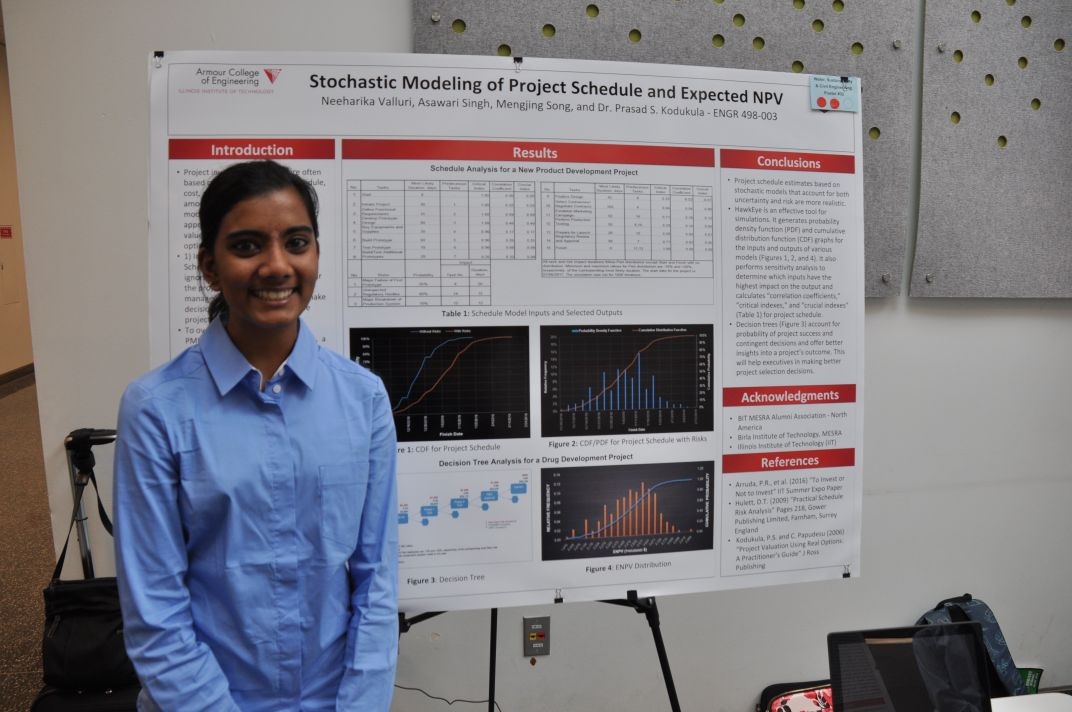
Neeharika Valluri
Production Engineering

Venkata Swaroop Matte
Computer Science Engineering
Jyotir Aditya
Civil Engineering
Utkarsh Gupta
Mechanical Engineering
Asawari Singh
Production Engineering
Manikandan Suresh
Mechanical Engineering
Pulkit Chawla
Information Technology
Adya Rateria
Bio Engineering
Nitin Agarwal
Civil Engineering
Manish Kumar
Civil Engineering
Shweta Shree
Bio Engineering

Shivankar
Production Engineering
Production Engineering
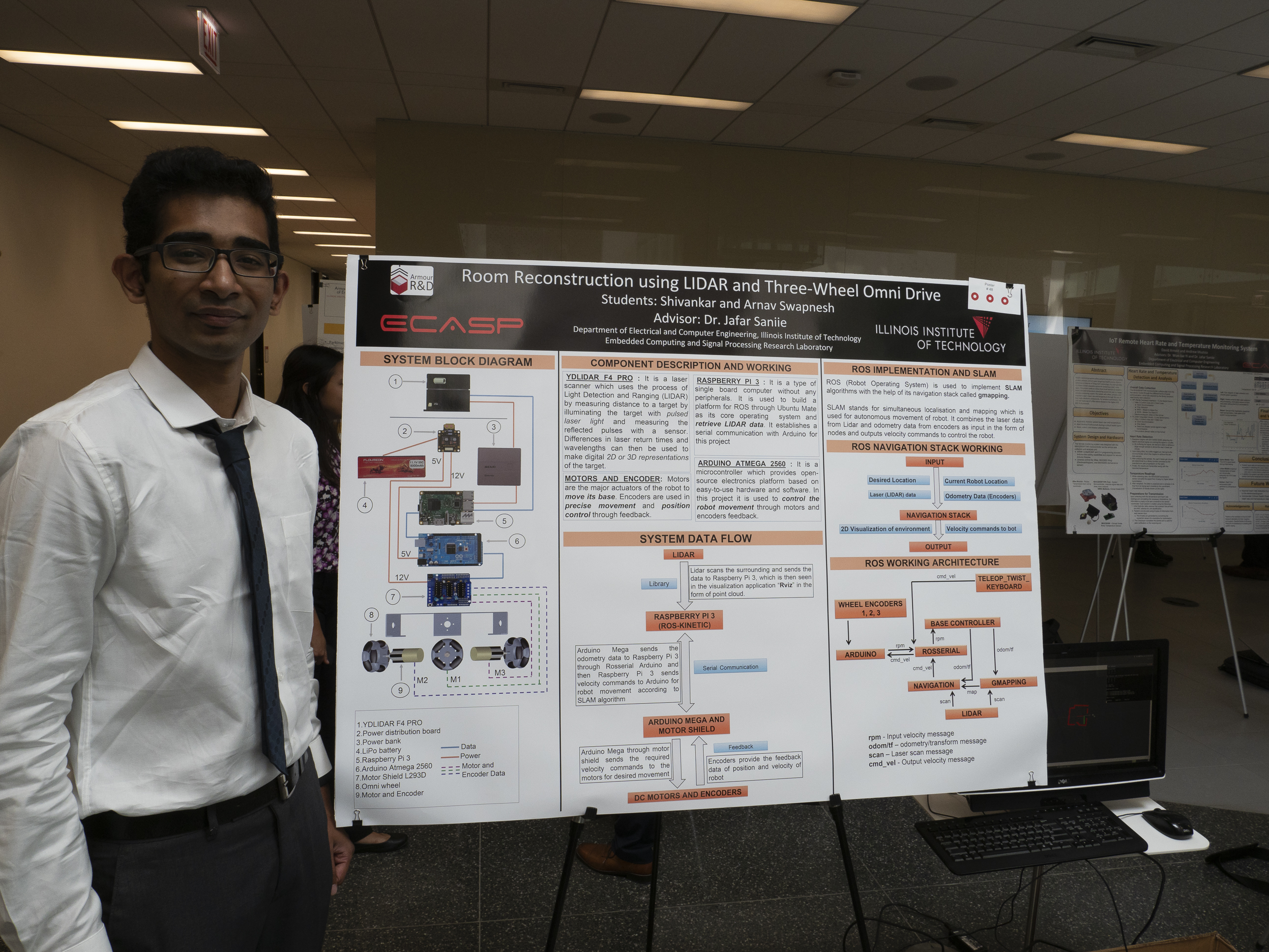
This project presents the design, validation and implementation of a three-wheeled holonomic motion system of a mobile robot designed to operate in homes or indoor spaces. The project analyses the kinematics of the motion system and validate the estimation of the trajectory comparing the displacement estimated with the internal odometry of the motors through encoders and the displacement estimated with a SLAM procedure based on LIDAR information.
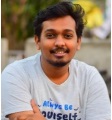
Arnav Swapnesh
Production Engineering
Production Engineering
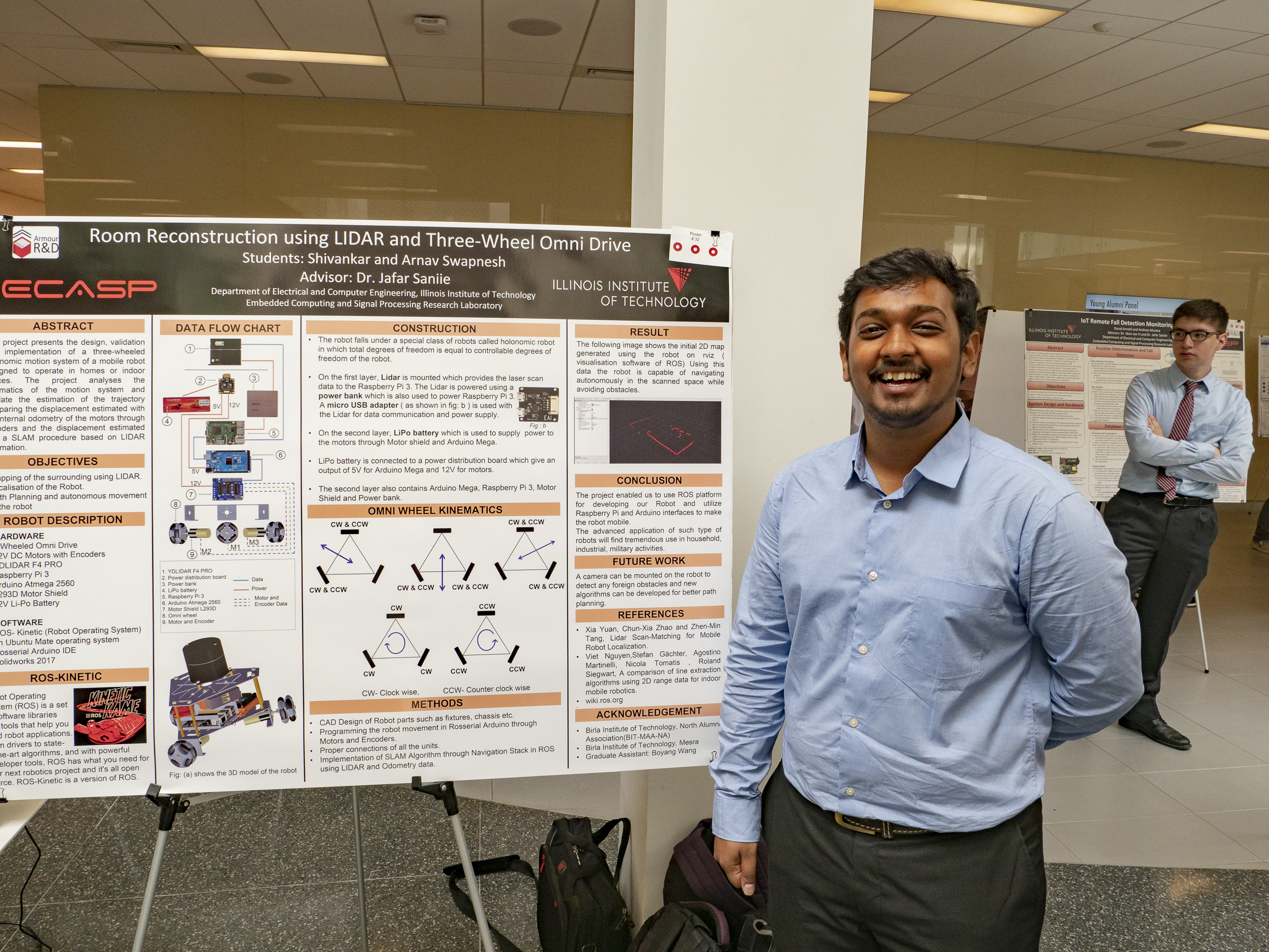
This project presents the design, validation and implementation of a three-wheeled holonomic motion system of a mobile robot designed to operate in homes or indoor spaces. The project analyses the kinematics of the motion system and validate the estimation of the trajectory comparing the displacement estimated with the internal odometry of the motors through encoders and the displacement estimated with a SLAM procedure based on LIDAR information.

SAUMYA PANDEY
ECE BRANCH
ECE BRANCH

ISRE research topic : In our research project, we as a group studied the major physical layer technologies which form the base for 5G networks. These physical layer technologies were subdivided into three major technologies (Non-Orthogonal Multiple Access Technology, Polar Code and Filtered-OFDM and massive-MIMO technology) among the three members of our group by our mentor.

SOURAV NAVAL
ECE BRANCH
ECE BRANCH
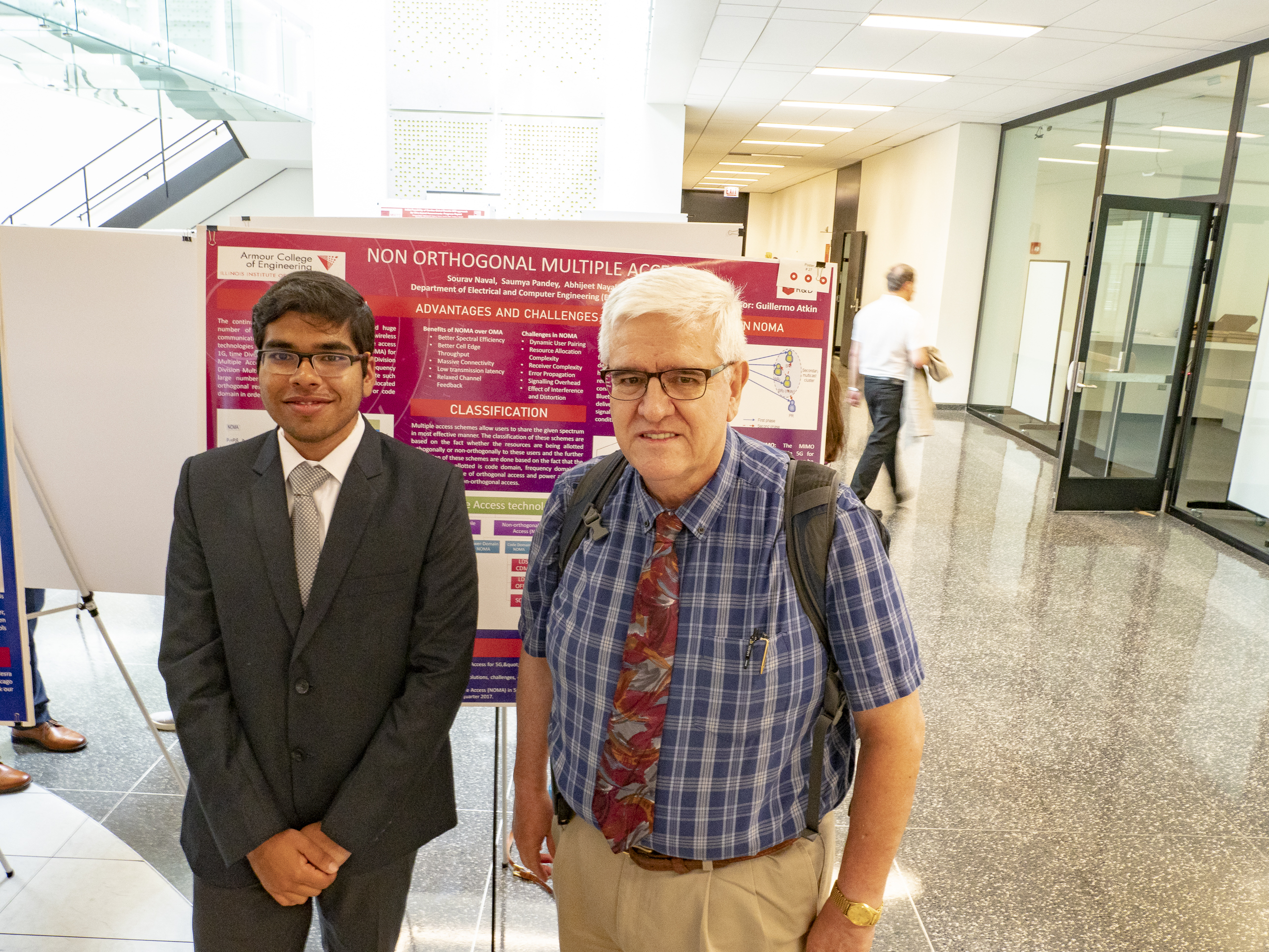
ISRE research topic : In our research project, we as a group studied the major physical layer technologies which form the base for 5G networks. These physical layer technologies were subdivided into three major technologies (Non-Orthogonal Multiple Access Technology, Polar Code and Filtered-OFDM and massive-MIMO technology) among the three members of our group by our mentor.
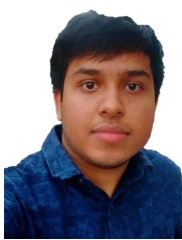
ABHIJEET NAYAK
ECE BRANCH
ECE BRANCH

ISRE research topic : In our research project, we as a group studied the major physical layer technologies which form the base for 5G networks. These physical layer technologies were subdivided into three major technologies (Non-Orthogonal Multiple Access Technology, Polar Code and Filtered-OFDM and massive-MIMO technology) among the three members of our group by our mentor.
Non-Orthogonal Multiple Access Technology is discussed among the New Radio (NR), which is a study item focussing on the design of next generation air interface. It is an upcoming multiple access technology specially designed for supporting 5G and future wireless communication scenarios which has improved features over traditionally used multiple access technologies in terms of better spectral efficiency, ability to accommodate larger number of users etc by virtue of its unique property of non-orthogonal resource allocation. NOMA can accommodate much more users via nonorthogonal resource allocation by allowing controllable interferences. Therefore, consistent and efficient encoding and decoding methods need to be constructed.
We studied various research papers and also performed simulations on MATLAB and Simulink platform for understanding the key features, advantages and various research trends related with this technology. The important facts were then presented in form of poster and a detailed report for final submission in the Armour R&D Expo. We presented a mathematical formulation for this problem and a developed a MATLAB code for testing the constellation characteristics based on the various input symbols from different users and then observed and compared the different constellation shapes and presented the findings to our mentor

Lakshmi Siva Surya
Teja Karri
BE/10646/15
BE/10646/15
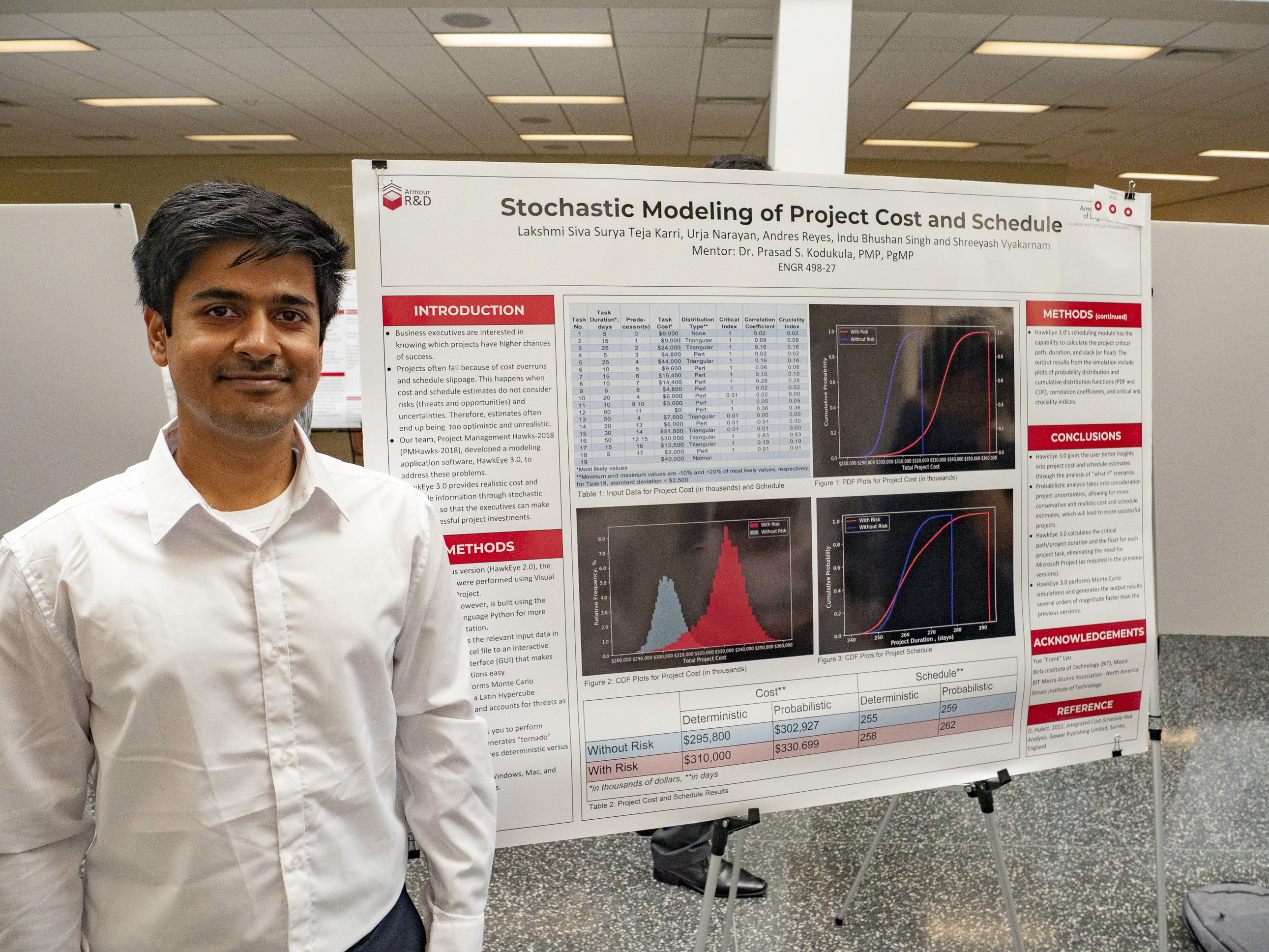
ABSTRACT:Business executives often face the challenge of deciding what projects to invest in. They need to know which projects will maximize the chances of success. Many projects fail because the project cost estimates do not consider the risk and uncertainty (threats and opportunity). The estimates are often too optimistic and unrealistic.
HawkEye is a simulation software that was developed by Project Management Hawks (PMHawks). While the team PMHawks-2016 built HawkEye 1.0 that calculated Project Cost, NPV estimation and Portfolio Optimization, PMHawks-2017 added functionalities like Project Schedule, NPV and Decision Trees in HawkEye 2.0.
Our team Project Management Hawks-2018 (PMHawks-2018) is a group of four enthusiastic students. We have developed a modeling application HawkEye 3.0 to solve the above stated problems for our immersive summer research experience. While the previous versions of HawkEye worked in collaboration with MS Project and Visual Basic, HawkEye 3.0 has altogether scraped the need of these two softwares by creating a model based on the programming language Python.
ACKNOWLEDGEMENTSWe are highly grateful to Birla Institute of Technology for its providing us with this great opportunity. We deeply acknowledge the constant support and encouragement of our respected alumni association BIT Mesra Alumni Association- North America (BITMAA-NA).
METHODSHawkEye 1.0 developed a Monte Carlo engine and used Latin Hypercube sampling method to calculate the calculate Project Cost, NPV estimation and Portfolio Optimization. While HawkEye 2.0 worked in tandem with MS Project to calculate the Project Schedule and NPV.
HawkEye 3.0 has completely eliminated the use of MS Project and Visual Basic which has increased the usability of the software.
It can also find total critical path time and the slack for the non- critical tasks. We have also included “Probabilistic branching”. The critical path can be calculated with risk as well as without risk in Project Schedule.
CONCLUSIONSHawkEye 3.0 is a more robust, powerful and faster modelling software for stochastic modelling of Project Cost, Project Schedule, NPV and Portfolio Optimization.
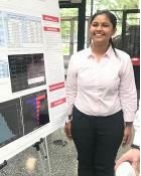
Urja Narayan
BE/10355/15
BE/10646/15
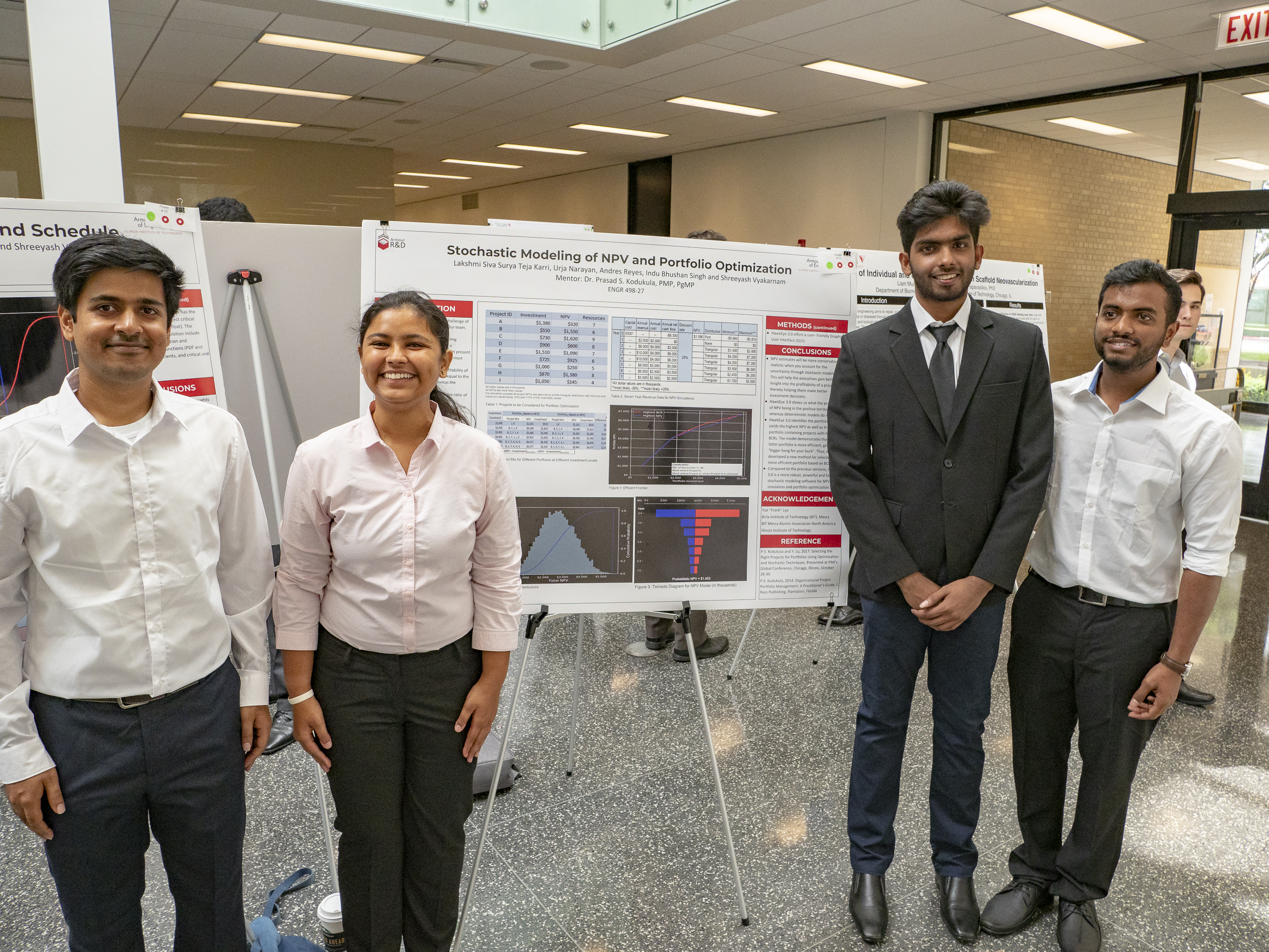
ABSTRACT:Business executives often face the challenge of deciding what projects to invest in. They need to know which projects will maximize the chances of success. Many projects fail because the project cost estimates do not consider the risk and uncertainty (threats and opportunity). The estimates are often too optimistic and unrealistic.
HawkEye is a simulation software that was developed by Project Management Hawks (PMHawks). While the team PMHawks-2016 built HawkEye 1.0 that calculated Project Cost, NPV estimation and Portfolio Optimization, PMHawks-2017 added functionalities like Project Schedule, NPV and Decision Trees in HawkEye 2.0.
We are highly grateful to Birla Institute of Technology for its providing us with this great opportunity. We deeply acknowledge the constant support and encouragement of our respected alumni association BIT Mesra Alumni Association- North America (BITMAA-NA).
METHODSHawkEye 1.0 developed a Monte Carlo engine and used Latin Hypercube sampling method to calculate the calculate Project Cost, NPV estimation and Portfolio Optimization. While HawkEye 2.0 worked in tandem with MS Project to calculate the Project Schedule and NPV.
HawkEye 3.0 has completely eliminated the use of MS Project and Visual Basic which has increased the usability of the software.
The user can calculate Project Cost, Schedule, and NPV as well as optimize Portfolios independently.
All the results are displayed in the form of interactive graphs and charts. The user can also get “tornado charts” to see the effect of the tasks on the complete project.
CONCLUSIONSHawkEye 3.0 is a more robust, powerful and faster modelling software for stochastic modelling of Project Cost, Project Schedule, NPV and Portfolio Optimization.

Shreeyash Vyakarnam
BE/10647/15
BE/10646/15
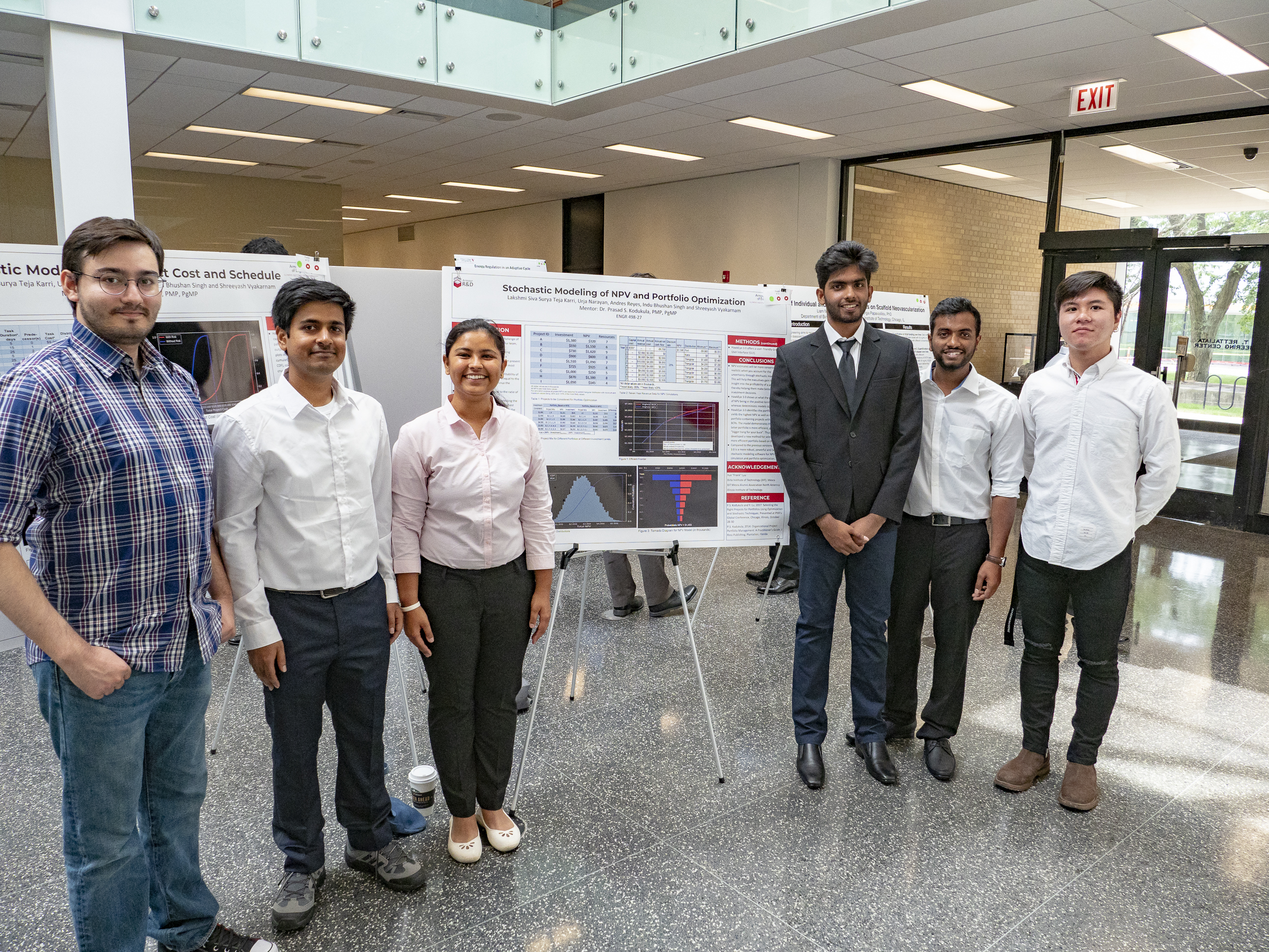
ABSTRACT:Business executives often face the challenge of deciding what projects to invest in. They need to know which projects will maximize the chances of success. Many projects fail because the project cost estimates do not consider the risk and uncertainty (threats and opportunity). The estimates are often too optimistic and unrealistic.
HawkEye is a simulation software that was developed by Project Management Hawks (PMHawks). While the team PMHawks-2016 built HawkEye 1.0 that calculated Project Cost, NPV estimation and Portfolio Optimization, PMHawks-2017 added functionalities like Project Schedule, NPV and Decision Trees in HawkEye 2.0.
Our team Project Management Hawks-2018 (PMHawks-2018) is a group of four enthusiastic students. We have developed a modeling application HawkEye 3.0 to solve the above stated problems for our immersive summer research experience. While the previous versions of HawkEye worked in collaboration with MS Project and Visual Basic, HawkEye 3.0 has altogether scraped the need of these two softwares by creating a model based on the programming language Python.
ACKNOWLEDGEMENTSWe are highly grateful to Birla Institute of Technology for its providing us with this great opportunity. We deeply acknowledge the constant support and encouragement of our respected alumni association BIT Mesra Alumni Association- North America (BITMAA-NA).
METHODSHawkEye 1.0 developed a Monte Carlo engine and used Latin Hypercube sampling method to calculate the calculate Project Cost, NPV estimation and Portfolio Optimization. While HawkEye 2.0 worked in tandem with MS Project to calculate the Project Schedule and NPV.
HawkEye 3.0 has completely eliminated the use of MS Project and Visual Basic which has increased the usability of the software.
The user can calculate Project Cost, Schedule, and NPV as well as optimize Portfolios independently.
All the results are displayed in the form of interactive graphs and charts. The user can also get “tornado charts” to see the effect of the tasks on the complete project.
The user has the independence to use the software in Windows, Mac and Linux. The platform independence has further simplified the usage.
PMHawks-2018 has also implemented “Portfolio Optimization” which gives the user the best portfolio mix. In the previous versions only the deterministic method was used to select the portfolio whereas HawkEye 3.0 can calculate it stochastically.
It can also find total critical path time and the slack for the non- critical tasks. We have also included “Probabilistic branching”. The critical path can be calculated with risk as well as without risk in Project Schedule.
CONCLUSIONSHawkEye 3.0 is a more robust, powerful and faster modelling software for stochastic modelling of Project Cost, Project Schedule, NPV and Portfolio Optimization.

Indu Bhushan Singh
BE/10194/15
BE/10646/15

ABSTRACT:Business executives often face the challenge of deciding what projects to invest in. They need to know which projects will maximize the chances of success. Many projects fail because the project cost estimates do not consider the risk and uncertainty (threats and opportunity). The estimates are often too optimistic and unrealistic.
HawkEye is a simulation software that was developed by Project Management Hawks (PMHawks). While the team PMHawks-2016 built HawkEye 1.0 that calculated Project Cost, NPV estimation and Portfolio Optimization, PMHawks-2017 added functionalities like Project Schedule, NPV and Decision Trees in HawkEye 2.0.
Our team Project Management Hawks-2018 (PMHawks-2018) is a group of four enthusiastic students. We have developed a modeling application HawkEye 3.0 to solve the above stated problems for our immersive summer research experience. While the previous versions of HawkEye worked in collaboration with MS Project and Visual Basic, HawkEye 3.0 has altogether scraped the need of these two softwares by creating a model based on the programming language Python.
ACKNOWLEDGEMENTSWe are highly grateful to Birla Institute of Technology for its providing us with this great opportunity. We deeply acknowledge the constant support and encouragement of our respected alumni association BIT Mesra Alumni Association- North America (BITMAA-NA).
METHODSHawkEye 1.0 developed a Monte Carlo engine and used Latin Hypercube sampling method to calculate the calculate Project Cost, NPV estimation and Portfolio Optimization. While HawkEye 2.0 worked in tandem with MS Project to calculate the Project Schedule and NPV.
HawkEye 3.0 has completely eliminated the use of MS Project and Visual Basic which has increased the usability of the software.
The user can calculate Project Cost, Schedule, and NPV as well as optimize Portfolios independently.
All the results are displayed in the form of interactive graphs and charts. The user can also get “tornado charts” to see the effect of the tasks on the complete project.
The user has the independence to use the software in Windows, Mac and Linux. The platform independence has further simplified the usage.
PMHawks-2018 has also implemented “Portfolio Optimization” which gives the user the best portfolio mix. In the previous versions only the deterministic method was used to select the portfolio whereas HawkEye 3.0 can calculate it stochastically.
It can also find total critical path time and the slack for the non- critical tasks. We have also included “Probabilistic branching”. The critical path can be calculated with risk as well as without risk in Project Schedule.
CONCLUSIONSHawkEye 3.0 is a more robust, powerful and faster modelling software for stochastic modelling of Project Cost, Project Schedule, NPV and Portfolio Optimization.
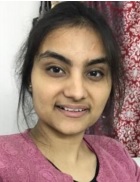
Akanksha Lakra
Chemical Engineering
Chemical Engineering
ISRE research topic :The rediscovery of Room Temperature Ionic Solvents as designer solvents promised a revolution in Synthetic Chemistry. RTILs hold promise as solvent free electrolytes for super capacitors, solar cells, batteries and electro actuators. First of all it is crucial to understand the electrical double layer concepts. It uses a Landau-Ginzburg type continuum theory of solvent free ionic liquids and use it to predict the structure of electrical double layer. Flows are described in correlated electrolytes and ionic liquids with only one new parameter , an electrostatic correlation length. This model captures over screening from short range correlations dominant at small voltages which are neglected in previous EDL theories. In this research I modified the normal Poisson equation to fourth order Poisson - Boltzmann equation which then was solved for small potential on colloidal surface (assumed as charged plate) in high concentrated electrolyte solution. Mathematical modeling of the model is done to find the force between charged plates. This model (Bazant's model) used a non- local kernel K(r,r') which decayed over length scale lc. The solutions obtained were then plotted on Matlab to give variation of potential versus distance between the plates and pressure versus correlation length. The plots obtained are shown as below:

Anushk Kamilla
BE CEE, BITM
Carnegie Mellon University, Pittsburgh, USA
(BE CEE, BITM)|| James Thompson(PhD)
ISRE research topic :In planning, designing and constructing a project, cost of construction has always been a prime concern for civil engineers and contractors. This is true today more than ever due to rampant urbanization. Therefore the objective is to study the parameters, that are either individually or jointly affecting the cost of any construction project. In simple words, our team was looking for factors that drove the cost for construction of a steel framed floor. This helps create a tool for engineers and builders to make economic decisions while planning a construction project.
Following the instruction of my advisor I started with an interior bay bounded by all direction and it was earlier assumed that the cost of the whole floor is the summation of those of each bay. For a typical interior bay, a slab with non-composite deck was selected with undraped reinforcement. The beams are supposed to be simply supported. Load distribution was taken care by the tributary area assumptions. A single aspect ratio i.e. a particular dimension of the bay was observed. Several plots were generated with help of spreadsheets corresponding to a bay area. The process was expanded for numerous other aspect ratios, each of which creates a possibility for a different spacing of the joists or wide flanged beams. Three dimensional plots were generated with the help of MATLAB and interpretations were made from it, where all the data could compacted in a single graph. Interpretations were made from the graphs produced. We also had aims of producing surface plots considering 3-4 factors that drive the cost of construction of floor. We did the same process for different orientation of the beams and joists in the bay and found some useful plots shown below. After all this work, we were asked to give a poster presentation on our work.
Vidur Ahluwalia
ISRE 2019 CMU
Chemical Engineering Dept

Satyabrat Bhol
Electronics and Communication Engg
ISRE 2019 IL Tech
Electronics and Communication Engg.
ISRE research topic: Data Analysis on Alzheimer's Disease where we will be applying Machine Learning and Deep Learning models to classify dementia and nondementia patients.

Soumil Dutta
Production Engineering
ISRE 2019 IL Tech
Production Engineering
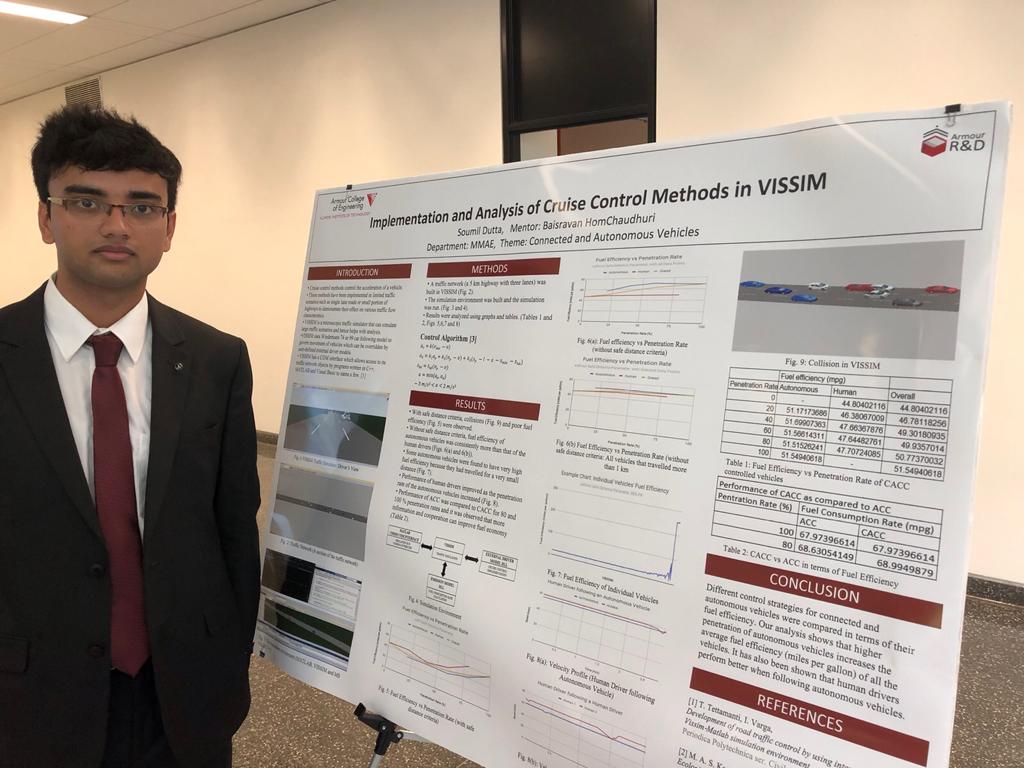 ISRE 2019 IL Tech Production Engineering
ISRE 2019 IL Tech Production Engineering
ISRE research topic: I am Soumil Dutta, graduating in 2020 from the Production Engineering Department of BIT Mesra. I was a part of Immersive Summer Research Experience (ISRE 2019) at Illinois Institute of Technology in Chicago. I would like to express heartfelt gratitude to BITMAA-NA who had taken this initiative three years ago and have continued to provide and facilitate us with this very, very rare opportunity.
My project was titled "Implementation and Analysis of Cruise Control Methods in VISSIM Traffic Simulator". Cruise Control methods are algorithms which control acceleration of an autonomous vehicle. In VISSIM a large traffic scenario is generated where we acquired data about the performance of vehicles in a more real world like scenario in contrast to simulations in MATLAB in which we can simulate only very few vehicles at a time. The code for cruise control method was written in C++ and was used to control some or all vehicles in the traffic simulation in VISSIM. We concluded that the overall fuel efficiency (miles per gallon) was better when there were more autonomous vehicles on the traffic network and it was also concluded that under the presence of autonomous vehicles, human drivers performed better in terms of fuel efficiency.
This project helped me to gain quite some relevant skills which I look forward to put into work in future. I got great insights as to how to write research papers. But most importantly I developed a work ethic which gave me an insight to how much can really be learnt and achieved in just eight weeks.
The combination of accommodation in IIT Chicago, the facilities, the great people and the flexibility of timings to work in the Rettaliatta Engineering Center made for a perfect research experience.
The beautifully and ingeniously planned city of Chicago, it's architecture, culture, it's libraries, museums and it's lifestyle made for a perfect life experience.

Shubh Goel
Mechanical Engineering
ISRE 2019 GA Tech
Mechanical Engineering
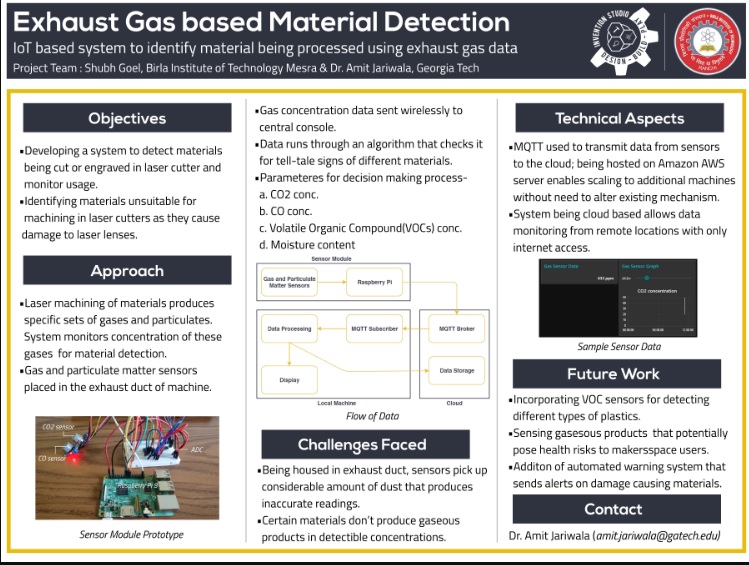
ISRE Research Topic: Possible applications of Internet of Things (IoT) technology in makespaces and implementing an Iot based data collection network at Georgia Tech's Flowers Invention Studio.

Ananya Gulati
Computer Science and Engineering
ISRE 2019 IL Tech
Computer Science and Engineering
ISRE Research Topic: Data Analysis for Alzheimer's' wherein I shall be applying Machine Learning algorithms to the Alzheimer's data set to understand the disease better. The study shall probe into the causes, prevention and cure of Alzheimer's disease.
Srishti Gupta
ISRE 2019 IL Tech

Mallika Khare
Electrical and Electronics Engineering
ISRE 2019 CMU
Electrical and Electronics Engineering
ISRE Research topic :Computer vision and deep learningElectrical and Computer Science Dept.

Shivam Mahajan
Mechanical Engineering
ISRE 2019 GA Tech
Mechanical Engineering

ISRE Research Topic: Rapid Prototyping for Product design.
Project Report for Shivam Mahajan1. Gain hands-on training in Invention Studio prototyping tools
2.Conduct research on training users on prototyping
a. Design a final checklist masterpiece that each trainee could build individually using a variety of prototyping tools. Example: multi-purpose toolbox
Skills Gained or in progress:1.Prototyping tools:
2.Research tools:
The project started with the aim to complete the checklist of the Flowers Invention Studio at George W. Woodruff School of Mechanical Engineering, Georgia Tech. The aim of the checklist was to teach the tools and prototyping methods that can be used at the Invention Studio.
While working on the checklist, I also started working with a team of six members including me. The aim of the project was to help develop he course which will help users on the subject of manufacturing and rapid prototyping. My work in this project was to design a new checklist masterpiece that the students taking the course would build and which would also replace the checklist at the Invention Studio.

Salini Mahapatra
ISRE 2019 IL Tech
Yashodeep Mahapatra
ISRE 2019 CMU
Electrical and Computer
Science Dept

Swapnil Modani
ISRE 2019 IL Tech
ISRE Research Topic: A user programmable homeautomation with cloud computation and image processing.

Aishanee Pattnaik
Chemical Engineering
ISRE 2019 GA Tech
Chemical Engineering


ISRE Research Topic: Development of salt purification processes of molten salts for its implementation on energy conservation.
UNDERGRADUATE PROJECT REPORTThe objective of this project is to conduct Cyclic Potentiodynamic Polarization tests on Molybdenum-Rhenium (MoRe) alloys used in small implant devices to determine its pitting corrosion susceptibility in accordance with the ASTM F2129 Standard (Standard Test Method for Conducting Cycling Potentiodynamic Polarization Measurements to Determine the Corrosion Susceptibility of Small Implant Devices) and compare its effective passive film formation.
THEORYSmall implant devices like vascular or ureteral stents, filters, cardiac occludes etcetera are often made of alloys that have a high resistance to corrosion, however if these surgical implants are susceptible to pitting or crevice corrosion they are likely to yield unwanted derogatory effects on nearby tissues, which might not be limited to malicious tumours. This experiment is designed to test the extent of passive film formation of varied compositions.
PROJECT 2The objective of this project is to construct and analyse a purification process for a molten fluoride salt FLiNaK, a ternary eutectic alkaline fluoride salt mixture of Lithium Fluoride (LiF), Sodium Fluoride (NaF) and Potassium Fluoride (KF).
THEORYFLiNaK, a ternary eutectic alkaline fluoride salt mixture of LiF-NaF-KF, is often used in corrosion experiments. They are produced by combining its high purity salt components, but still contain enough impurities to cause a derogatory effects on corrosion experiments. This process aims to produce high purity FLiNaK by hydro-fluorination of fluoride salts, ramped to 600°C, and a Hydrogen (H2) and Hydrogen Fluoride (HF) spurge followed by switching to an Argon spurge for 24 hours. HF converts the oxides and to fluorides and both HF and H2 are responsible for reducing metal fluorides. HF will be generated in-situ from the thermal decomposition of Ammonium Bi-fluoride (NH4HF2) to avoid costs for the specialized equipment required for the safe handling of HF.

Anamika Medha Shekhar
Civil and Environmental Engineering Dept
ISRE 2019 CMU
Civil and Environmental Engineering Dept
ISRE Research Topic:Transportation Data analysis. There is a construction going on just infront of CMU campus which changes 2 lanes to one lane. We are concerned how the change in lane affects traffic or speed or pollution.

Shreyas Shubhankar
Electrical and Electronics Engineering
ISRE 2019 IL Tech
Electrical and Electronics Engineering
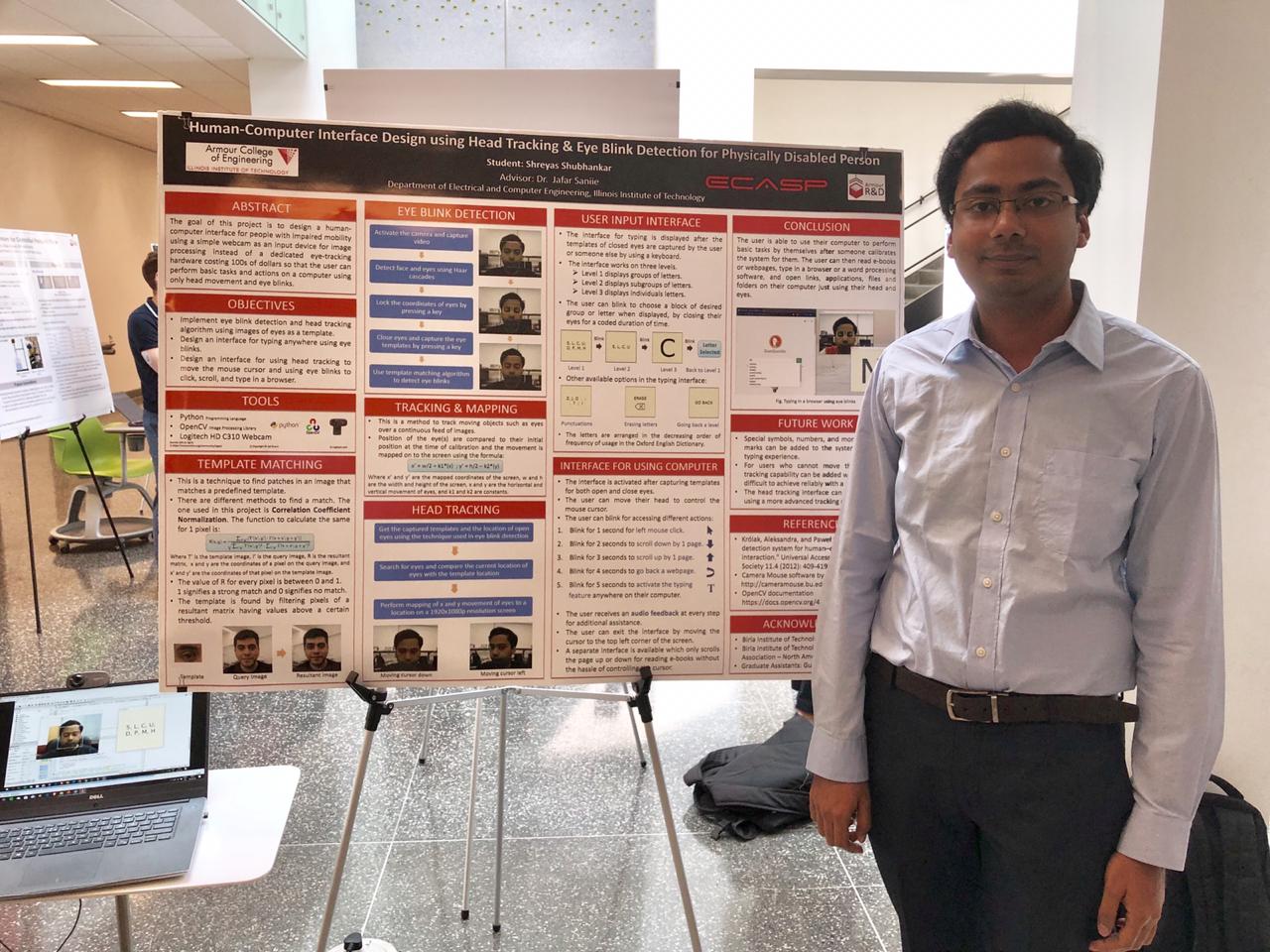
ISRE Research Topic: Hello! My name is Shreyas Shubhankar. I'm currently in the final year of Electrical and Electronics Engineering at BIT Mesra and will be graduating in 2020. I interned at Illinois Institute of Technology, Chicago under the ISRE 2019 program.
I worked under Dr. Jafar Saniie in the Electrical and Computer Engineering department. The project was centered around a topic in Electrical Engineering called “Image Processing”. The goal of my project was to implement eye blink detection and head tracking algorithm using images of eyes as a template, to design a user friendly interface for typing anywhere using eye blinks, and to design an interface for using head tracking to move the mouse cursor and using eye blinks to click, scroll, and type in a browser. These algorithms help people with disabilities who cannot use their hands or voice to control their computer.
Here is the video link where I describe my project in further detail:
My project in further detail.
Participating in the ISRE program exposes you to an amalgam of cultures as there is an opportunity to work with some of the best minds from all over the world. You also get an exposure to the excellent academic and research system of the US. Needless to say, it is one of the best internship experience you can get during your undergrad and if you're planning for higher studies, this internship is priceless.
I would like to thank Birla Institute of Technology, Mesra, IIT Chicago, and BITMAA-NA for making this wonderful opportunity possible.

Nishant Kumar Singh
Civil and Environmental Engineering
ISRE 2019 CMU
Civil and Environmental Engineering
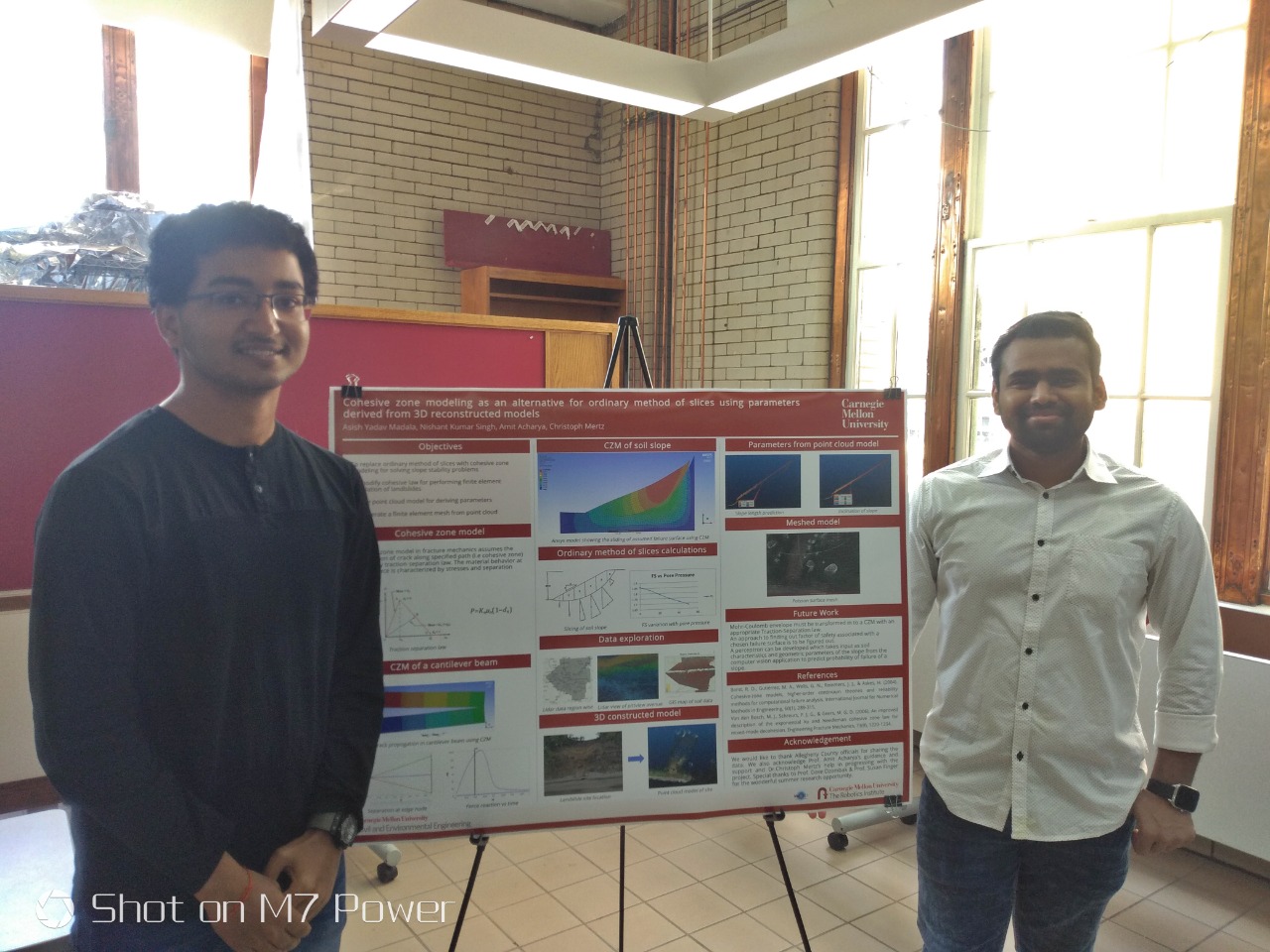
ISRE Research Topic:
Hello everyone,
I am Nishant Kumar Singh of batch 2016-20 pursuing B.E in Civil Engineering at BIT MESRA.
I was a student research intern at Carnegie Mellon University in the summer of 2019.
Landslide occurs frequently in India. The Method of slices has
been used to analyze slope stability of inclines but it has its limitations. I worked on the topic 'Cohesive Zone model as an alternative for the ordinary method of slices using parameters derived from the 3D reconstructed models'. My work was to analyse the methods used to study slope stability using mathematical models and codes and to simulate a new method and try to overcome the limitations of the earlier method to analyse landslides.
Not only did I learn the subject but also how to learn things. I loved the atmosphere of learning and growing continuously.
I will always carry with me politeness, respectfulness and the persevering nature of the Americans. I learned a lot from the different culture I was exposed to and made friends from all across the globe. I am grateful for this opportunity and I thank BIT MESRA, BITMAA-NA and CMU,Pittsburgh for this fantastic experience.

Paritosh Kumar Sinha
Electronics and Communication
Engineering
ISRE 2019 IL Tech
Electronics and Communication
Engineering
ISRE Research Topic: Field Programmable Gate Arrays (FPGA's) to develop a programmable system on chip. For now I am learning about the topic and will have a project finalized by Friday 14th June.
Copyright © 2025. All rights reserved.